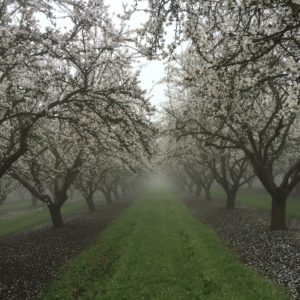
Spraying trees during bloom and in the early spring is different than spraying in the summer. This is due to the reduced canopy which allows easier movement of the droplets. Rig speed, therefore, can be increased to help cover the orchard more quickly. Speeds from 3-3.5 mph (4.5-5.5 km/hr) are more common during this period. This contrasts with hull-split sprays which are typically done between 2.0-2.5 mph (3.2-4 km/hr).
Many operations have considered every-other-row spray applications during bloom. Although not ideal, this strategy works reasonably well in lower density, small canopied, or young orchards. As the trees increase in size, however, the amount of wood within the canopy increases. This reduces the distribution of spray droplets through the tree, reducing protection on the unsprayed side. Spray rig speed must be moderate (~2.75-3.00 mph) and volume should be high (80-110 gpa, 750-1000 liters/ha) if using this strategy to improve canopy penetration by the droplet. I use this strategy for younger blocks when rain risk is high but uncertain– a spray is made to “side A”, with a follow-up spray made 7 days later to “side B.” I typically follow up these two “half sprays” with a full spray using a different fungicide chemistry 7 days after the completion of the “B-side.” I only use this strategy for years 3 and 4 (up to 40% canopy coverage).
In densely planted orchards, rig speed should be reduced (Figure 1). Increased tree density increases the amount of wood that blocks the distribution of droplets. To compensate, slower speeds must be utilized to improve air displacement and droplet movement. This would also be needed in orchards that have tall trees and have a lot of vertical wood growth. Every-other-row spraying should not be considered in these orchards due to the lack of coverage on the alternating side. This can lead to disease outbreaks within these areas of the trees.
Knowing rig speed is helpful in estimating the time to spray orchard blocks. An estimate can be determined by dividing the area of the orchard by the row spacing, then dividing again by speed. Table 1a and 1b provide a time estimate to spray commonly used Row spacings for acres and hectares. This estimate can help determine equipment needs and direct effort. However, since it is only as estimate, bear in mind that it does not account for the time to fill-up and mix the spray rig, distance traveled from the fill station to the field, and turn arounds at the end of the row. Small, irregular sized blocks, therefore, will take longer to spray per area than larger, regularly shaped blocks. As applications are made, a more refined estimate can be determined specific to an operation.

Understanding the operational capacity to spray can aid decisions on fungicides. Fungicides work best if applied before infection events (i.e. rain events). If it takes 5 days to spray the orchard, a decision on making a fungicide application must be made 6-10 days in advance of the target coverage date. This timing is even more important if the operation is using rain to determine the need to spray rather than a “calendar approach.”
Spraying fungicides based on the weather is an effective way to maintain tree health while potentially reducing operational expenses. In a typical year, it may be possible to skip several sprays if the weather conditions are without rain. This reduces chemical and application costs. In rainy conditions, it is not advisable to skip sprays. Fungicide protection should be applied before a rain event, and re-applied every 10-14 days during wet periods. Some great tips are included in this article from 2020 and this article about fungicide programs from 2021.
Even in a dry year, not all sprays should be skipped. Research and personal experiences have indicated that sprays at petal fall and in the springtime are needed to prevent various diseases, regardless of weather conditions. This is especially true if heavy dews are consistently present. These sprays often target the pathogens that cause jacket rot, scab, rust, and anthracnose.


Giorgi
February 6, 2022When one refers to dosage in tree orchards (eg 1000L/Ha), do you include the rows inbetween the trees, or only the tree rows? For example if the trees are planted 6m wide, then in one hectare you have 0.2ha of trees. Do you therefore apply 200L /Ha or 1000L /Ha here?
Davidd
February 10, 2022The dosage is for the orchard ha, which includes the spacing in between the trees. For example, if an orchard is planted at 4m (tree) x 6.5m (row), that is roughly 385 trees/ha. The application volume would cover the tree and the space in between, so each tree spacing should receive about 2.5 liters of liquid (1.25 applied to each side).